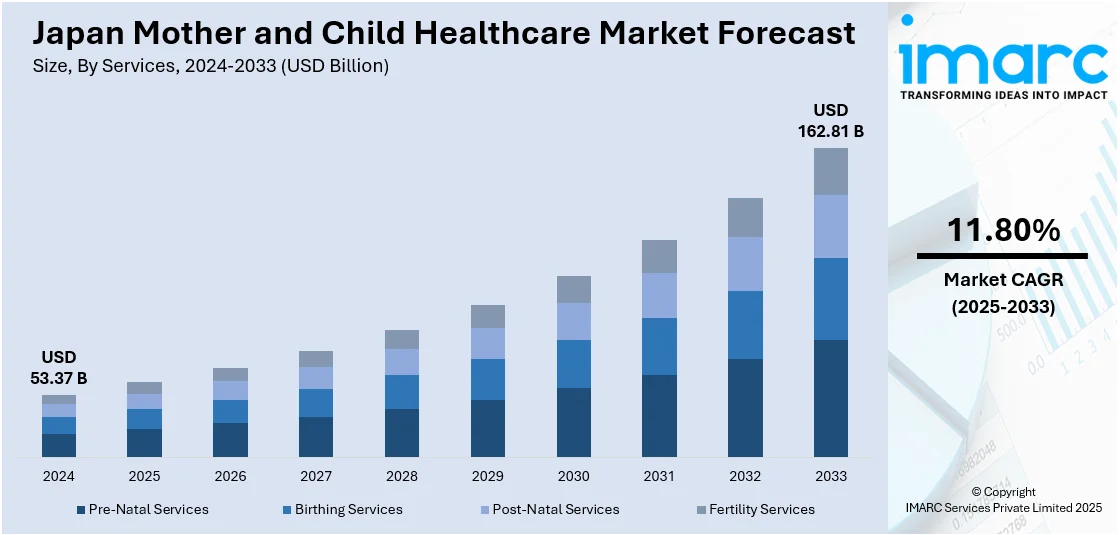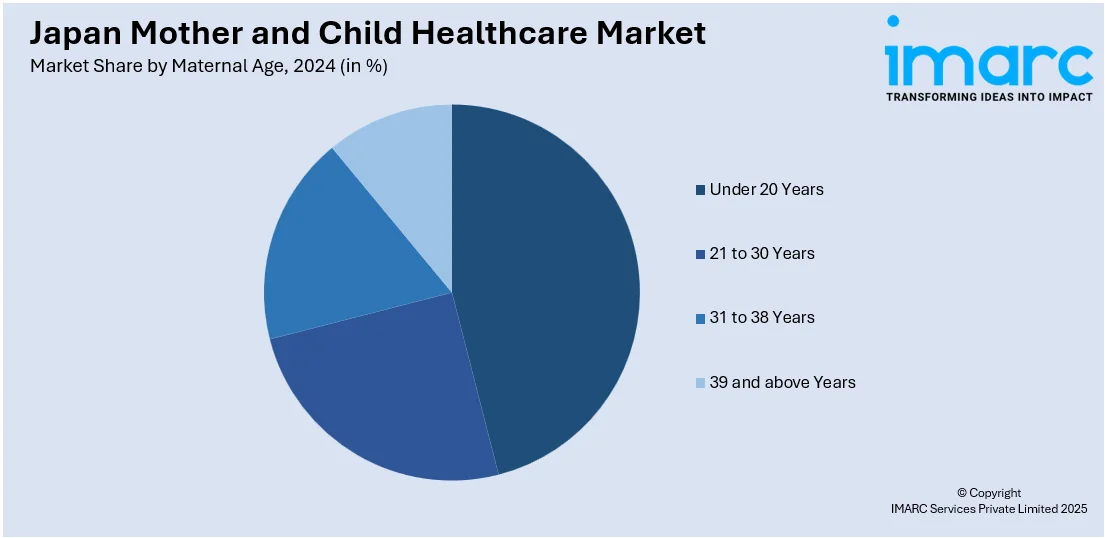
Japan Mother and Child Healthcare Market Size, Share, Trends and Forecast by Services, Maternal Age, Location, and Region, 2025-2033
Japan Mother and Child Healthcare Market Overview:
The Japan mother and child healthcare market size reached USD 53.37 Billion in 2024. Looking forward, IMARC Group expects the market to reach USD 162.81 Billion by 2033, exhibiting a growth rate (CAGR) of 11.80% during 2025-2033. Rising awareness about the importance of maternal and neonatal health, supportive government policies, technological integration in perinatal care, and increased demand for personalized healthcare services are driving Japan's mother and child healthcare market, as the country focuses on reversing declining birth rates and enhancing overall maternal well-being across both urban and rural populations.
|
Report Attribute
|
Key Statistics
|
|---|---|
|
Base Year
|
2024 |
|
Forecast Years
|
2025-2033
|
|
Historical Years
|
2019-2024
|
| Market Size in 2024 | USD 53.37 Billion |
| Market Forecast in 2033 | USD 162.81 Billion |
| Market Growth Rate 2025-2033 | 11.80% |
Japan Mother and Child Healthcare Market Trends:
Aging Population and Fertility Incentives Leading to Improved Maternal Support Systems
Japan has one of the oldest demographics globally, with a median age over 48 years. Due to this demographic imbalance, the Japanese government has accelerated its efforts towards boosting birth rates through better maternal and child healthcare infrastructure. One of the major strategies has been to develop a stronger support system for future and new mothers. The market is driven by the government's efforts to make childbearing less expensive and stressful. These efforts involve extended insurance coverage for prenatal and postnatal care, childbirth subsidies, and easier access to maternity leave and workplace flexibility. Municipal governments are also boosting investments in perinatal care centers, digital health monitoring apps for pregnant women, and home-based pediatric services. By enhancing access to care and lowering the cost of childbirth, the system hopes to make parenting a more viable and appealing option for young couples. This pressure has prompted the demand for quality obstetrics, neonatal devices, prenatal diagnostic tools, and maternal mental health care. Industry participants are reacting with new-age solutions, such as telemedicine solutions, maternal nutrition supplements, and customized prenatal care solutions.

Technological Advancement and Integration of Digital Health Solutions
Another key driver is the accelerated adoption of advanced digital health technologies. Japan, with its robust tech ecosystem and culture of innovation, is at the forefront of using AI, IoT, and data analytics to maternal and pediatric healthcare. This is a market-led change in which private sector innovation is the driving force rather than policy-driven support systems. Digital pregnancy monitoring devices, fetal health wearables, artificial intelligence-driven ultrasound imaging systems, and cloud-based record management systems for medicine are gaining popularity among healthcare professionals and consumers. Not only do they enhance the precision of diagnosis, but they also facilitate timely intervention of complicated pregnancies, lowering the rate of complications and mortality. In addition, mobile health applications designed specifically for pregnant women and new mothers provide personalized advice on care, reminder notices for appointments, as well as online consultation with obstetricians and pediatricians. Japan's highly developed telecommunication infrastructure means that such services are widely available, even in rural communities.
Japan Mother and Child Healthcare Market Segmentation:
IMARC Group provides an analysis of the key trends in each segment of the market, along with forecasts at the region/country level for 2025-2033. Our report has categorized the market based on services, maternal age, and location.
Services Insights:
- Pre-Natal Services
- Birthing Services
- Post-Natal Services
- Fertility Services
The report has provided a detailed breakup and analysis of the market based on the services. This includes pre-natal services, birthing services, post-natal services, and fertility services.
Maternal Age Insights:

- Under 20 Years
- 21 to 30 Years
- 31 to 38 Years
- 39 and above Years
A detailed breakup and analysis of the market based on the maternal age have also been provided in the report. This includes under 20 years, 21 to 30 years, 31 to 38 years, and 39 and above years.
Location Insights:
- Hospitals
- Nursing Homes and Clinics
- In-Home Services
- Others
The report has provided a detailed breakup and analysis of the market based on the location. This includes hospitals, nursing homes and clinics, in-home services, and others.
Regional Insights:
- Kanto Region
- Kansai/Kinki Region
- Central/Chubu Region
- Kyushu-Okinawa Region
- Tohoku Region
- Chugoku Region
- Hokkaido Region
- Shikoku Region
The report has also provided a comprehensive analysis of all the major regional markets, which include Kanto Region, Kansai/Kinki Region, Central/Chubu Region, Kyushu-Okinawa Region, Tohoku Region, Chugoku Region, Hokkaido Region, and Shikoku Region.
Competitive Landscape:
The market research report has also provided a comprehensive analysis of the competitive landscape. Competitive analysis such as market structure, key player positioning, top winning strategies, competitive dashboard, and company evaluation quadrant has been covered in the report. Also, detailed profiles of all major companies have been provided.
Japan Mother and Child Healthcare Market News:
- January 2025: The Government of Tokyo announced that it would subsidize painless childbirth, offering up to JPY 100,000 for epidural deliveries starting October 2025. This initiative aims to alleviate the financial burden of labor pain relief, which typically costs up to JPY 200,000.
- August 2024: Japan's Children and Families Agency announced plans to revise guidelines to include women who temporarily stay at their parents' homes to give birth and those who have experienced miscarriages or stillbirths. These revisions aim to ensure equal access to care services for all women in need, promoting comprehensive mental and physical support during the postpartum period.
Japan Mother and Child Healthcare Market Report Coverage:
| Report Features | Details |
|---|---|
| Base Year of the Analysis | 2024 |
| Historical Period | 2019-2024 |
| Forecast Period | 2025-2033 |
| Units | Billion USD |
| Scope of the Report |
Exploration of Historical Trends and Market Outlook, Industry Catalysts and Challenges, Segment-Wise Historical and Future Market Assessment:
|
| Services Covered | Pre-Natal Services, Birthing Services, Post-Natal Services, Fertility Services |
| Maternal Ages Covered | Under 20 Years, 21 to 30 Years, 31 to 38 Years, 39 and above Years |
| Locations Covered | Hospitals, Nursing Homes and Clinics, In-Home Services, Others |
| Regions Covered | Kanto Region, Kansai/Kinki Region, Central/Chubu Region, Kyushu-Okinawa Region, Tohoku Region, Chugoku Region, Hokkaido Region, Shikoku Region |
| Customization Scope | 10% Free Customization |
| Post-Sale Analyst Support | 10-12 Weeks |
| Delivery Format | PDF and Excel through Email (We can also provide the editable version of the report in PPT/Word format on special request) |
Key Questions Answered in This Report:
- How has the Japan mother and child healthcare market performed so far and how will it perform in the coming years?
- What is the breakup of the Japan mother and child healthcare market on the basis of services?
- What is the breakup of the Japan mother and child healthcare market on the basis of maternal age?
- What is the breakup of the Japan mother and child healthcare market on the basis of location?
- What is the breakup of the Japan mother and child healthcare market on the basis of region?
- What are the various stages in the value chain of the Japan mother and child healthcare market?
- What are the key driving factors and challenges in the Japan mother and child healthcare market?
- What is the structure of the Japan mother and child healthcare market and who are the key players?
- What is the degree of competition in the Japan mother and child healthcare market?
Key Benefits for Stakeholders:
- IMARC’s industry report offers a comprehensive quantitative analysis of various market segments, historical and current market trends, market forecasts, and dynamics of the Japan mother and child healthcare market from 2019-2033.
- The research report provides the latest information on the market drivers, challenges, and opportunities in the Japan mother and child healthcare market.
- Porter's five forces analysis assist stakeholders in assessing the impact of new entrants, competitive rivalry, supplier power, buyer power, and the threat of substitution. It helps stakeholders to analyze the level of competition within the Japan mother and child healthcare industry and its attractiveness.
- Competitive landscape allows stakeholders to understand their competitive environment and provides an insight into the current positions of key players in the market.
Need more help?
- Speak to our experienced analysts for insights on the current market scenarios.
- Include additional segments and countries to customize the report as per your requirement.
- Gain an unparalleled competitive advantage in your domain by understanding how to utilize the report and positively impacting your operations and revenue.
- For further assistance, please connect with our analysts.
 Request Customization
Request Customization
 Speak to an Analyst
Speak to an Analyst
 Request Brochure
Request Brochure
 Inquire Before Buying
Inquire Before Buying




.webp)




.webp)












